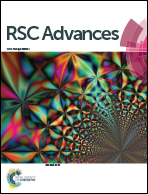Kinetic study of carbene polymerization of ethyl diazoacetate by palladium and rhodium catalysts†
Abstract
Kinetic studies of the carbene polymerization of ethyl diazoacetate (EDA) by palladium (Pd) or rhodium (Rh) catalysts were investigated by real-time Fourier transform infrared (FTIR) spectroscopy. Both (L-prolinate)RhI(1,5-cyclooctadiene) and (L-prolinate)RhI(2,5-norbornadiene) mediated EDA polymerization were proved to be first order reactions, suggesting that the formation of “Rh-carbenoid” is the rate determining step. The activation energy (11.24 kJ mol−1) of the polymerization of “carbenes” generated from EDA with (L-prolinate)RhI(1,5-cyclooctadiene) as the catalyst was calculated from kinetic data via the Arrhenius equation. On the other hand, the polymerizations of EDA catalyzed by three kinds of Pd-catalysts were revealed as zero order reactions, suggesting that the rate determining step involves the formation of an EDA–Pd transition state complex through a coordinated step. Refilling more EDA to the (bis(acetonitrile)dichloropalladium)-mediated carbene polymerization system did not change the reaction order. The rate constant increases gradually with the increase of the dosage of the catalyst and decreases with the cycle-index, which proves the formation of “EDA–Pd transition state complex” and the propagating species with Pd–C bonds at the end of the polymer chain.


 Please wait while we load your content...
Please wait while we load your content...